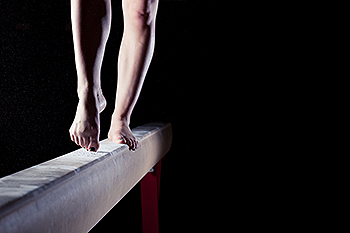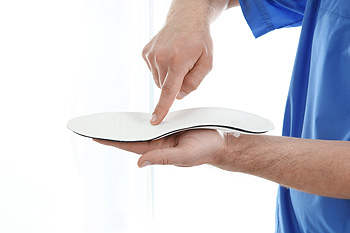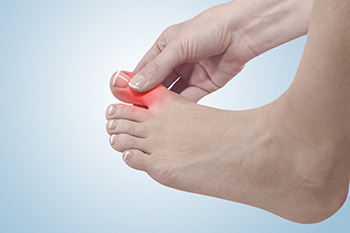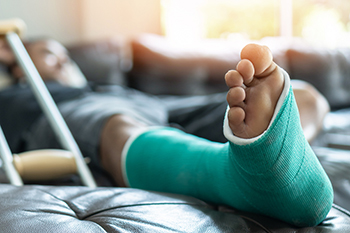Items filtered by date: May 2022
Ankle Sprains in High School Sports

Ankle sprains are the most common injury sustained in high school sports. Most of these sprains heal within a week and without surgery. However, given the preponderance of this injury, awareness and prevention measures should be employed for this age group. Sports requiring running and jumping, like basketball, soccer, and gymnastics, commonly lead to ankle sprains. This injury often involves contact with another player within the sport. Prior injury is a risk factor for future ankle sprains. It is unclear whether wearing an ankle brace helps to prevent or increase the risk of ankle sprains. What is known is that if one sustains an ankle sprain, it is important to let it heal sufficiently before reengaging in the sport. Also, strengthening exercises can have beneficial effects on reducing the risk of ankle sprains. Repeated trauma to the ankle that is not treated can lead to chronic ankle instability and ankle osteoarthritis over one’s lifespan. If your high schooler participates in sports and sprains an ankle, it is a good idea to see a chiropodist to properly diagnose the severity of the sprain and obtain treatment.
Injuries to the foot and ankle are very common among athletes. If you have experienced an injury, please consult with one of the chiropodists from Complete Family Footcare & Therapy. Our clinicians will assess your condition and provide you with quality foot and ankle treatment.
Common Injuries Among Athletes:
-
Achilles tendon injuries
-
Ankle strains or sprains
-
Plantar fasciitis
-
Fractures
-
Turf toe
-
Joint dislocations
-
Sever’s disease
-
Morton’s neuroma
Symptoms
Symptoms will depend on the cause and severity of the injury. Common symptoms for a foot or ankle injury include pain, swelling, tenderness, bruising, a reduced range of motion, and difficulty bearing weight or walking on the affected foot or ankle.
Diagnosis
Sports injuries are typically diagnosed after carefully examining the affected foot or ankle. This includes moving the injured area to test its range of motion. Medical history will need to be provided, as well as detailed information about how the injury occurred. Imaging studies, such as X-rays or MRIs, may be used to confirm or rule out certain diagnoses.
Treatment
Just like symptoms, treatment will depend on the type of injury and its severity. Initial treatment for many sports injuries is aimed at controlling inflammation and promoting the healing response. The acronym R.I.C.E is a helpful guide to implement for most acute injuries. This method involves resting, icing, compressing, and elevating the affected foot or ankle. In addition, anti-inflammatory medications may be administered and orthotic devices may be prescribed. For more severe injuries, surgery may be required. Lastly, rehabilitation or physical therapy may be needed to gain full functionality in the afflicted area.
If you have any questions, please feel free to contact our offices located in . We offer the newest diagnostic and treatment technologies for all your foot care needs.
How Custom Orthotics May Help Your Foot Condition

If you have plantar fasciitis, heel spurs, a diabetic foot condition, neuropathy, or another painful foot condition, custom orthotics may provide relief. Custom orthotics are created to address your specific issue and are designed to fit your actual feet—as opposed to off-the-shelf insoles. A chiropodist can determine the cause of your foot discomfort or impeded mobility and provide a custom orthotic to treat it. Your specific condition, weight, lifestyle, and shoe size will be taken into consideration to determine what type of orthotic you need. The orthotic may be functional (geared towards controlling foot biomechanics) or accommodative (designed to protect/relieve certain areas and compensate for changes in foot functionality). Functional orthotics are typically thin and firm, while accommodative orthotics are usually less rigid and bulkier. It is suggested that you consult with a chiropodist to see if custom orthotics can help your painful foot condition or mobility issue.
Orthotics are devices that are typically inserted into shoes to treat a variety of foot and ankle problems. If you would like to learn more, please consult with one of the chiropodists from Complete Family Footcare & Therapy. Our clinicians can help you maintain the health of your lower limbs and your mobility.
What Are Orthotics Used For?
Orthotics are used for the treatment of a variety of foot and ankle problems. These can include biomechanical issues, gait abnormalities, foot pain, injuries, arthritis, deformities, and other medical conditions that affect the lower limbs. Orthotics can be bought in a store or custom-made and prescribed by a chiropodist.
Types of Orthotics
-
Rigid - Made from carbon fiber or other hard material and designed to ease foot pain and strain
-
Soft - Made from flexible materials like foam and designed to cushion and support the foot
-
Full shoe inserts
-
Half shoe inserts
-
Heel cups
-
Heel pads
-
Night splints
-
Braces
-
And more
If you have any questions, please feel free to contact our offices located in . We offer the newest diagnostic and treatment technologies for all your foot care needs.
Being at Risk for Gout

Gout is a form of inflammatory arthritis that usually affects the big toe joint but can also affect other toes, the ankle, and knee. The main symptom of gout that is difficult to ignore is intense pain, even sometimes intermittently. There might also be swelling, redness, and a heat sensation. Gout is caused by hyperuricemia, where too much uric acid collects from the breakdown of purines in the body that may come from the foods you eat. When there is too much uric acid, uric acid crystals (monosodium urate) build up in joints and tissues in the body which may turn into gout. Males certain health conditions (such as obesity, congestive heart failure, high blood pressure, and diabetes) as well as alcohol consumption, consumption of sugary foods or foods rich in purines – red meat and some kinds of seafood - can increase one's' risk of gout. Repeated bouts of gout can aggravate this form of arthritis. Results of a physical exam and any X-rays or lab work suggested, can confirm a diagnosis of gout. See a chiropodist if you are experiencing pain and related symptoms in your toe joints for proper diagnosis and a suggested treatment plan.
Gout is a painful form of arthritis that can affect anyone. Please consult with one of the chiropodists from Complete Family Footcare & Therapy. Our clinicians will assess your condition and provide you with quality foot and ankle treatment.
What Is Gout?
Gout is characterized by sudden, severe attacks of pain, redness, and tenderness in the joints. This type of arthritis is caused by a buildup of uric acid in the bloodstream. When uric acid crystallizes in a joint, often the joint of the big toe, it can bring about a gout attack.
Symptoms
Symptoms of gout include:
-
Sudden and severe pain
-
Swelling
-
Redness
-
Warmth
-
Joint stiffness
-
Joint deformity
Diagnosis
A chiropodist will ask questions about your personal and family medical history, followed by an examination of the affected joint. Laboratory tests and x-rays are sometimes ordered to determine if the inflammation is caused by something other than gout. A sample of fluid taken from your joint can show whether it contains uric acid.
Treatment
Prescription medications or injections are used to treat the pain, swelling, and inflammation. Patients with chronic gout can also use behavioral modifications such as diet, exercise, and decreased intake of alcohol to help minimize the frequency of gout attacks. Foods and beverages that are high in purines should be avoided since purines are converted in the body to uric acid. If left untreated, this painful condition can leave your joint permanently damaged and swollen.
If you have any questions, please feel free to contact our offices located in . We offer the newest diagnostic and treatment technologies for all your foot care needs.
Arthritis Can Cause Pain in the Feet and Ankles
Ways to Avoid Toenail Fungus

If you notice that your toenail has turned yellow or green and has become thickened and brittle, you may have developed onychomycosis. This is an infection that is caused by a fungus called dermatophytes, which also causes athlete's foot. Although a fungal toenail infection is unsightly, it’s not particularly dangerous or severe. It is, however, quite contagious. The fungus thrives in places that are moist and warm, such as public shower rooms, swimming pools and locker rooms. You also may be at risk if you are over 60, have diabetes, psoriasis or poor circulation, have a weakened immune system, have damaged nails, or smoke. The first way to prevent infection is to avoid going barefoot in locker or changing rooms at the gym or swimming pool. Keep your feet clean and dry, especially the area between the toes. Wear clean socks, and replace old shoes that may be a fungal breeding ground. Keep your toenails trimmed, and don’t share your nail clippers. A number of antifungal sprays and other products are available from the pharmacy that can be taken at home. If after two weeks your toenail infection has not improved, it is a good idea to see a chiropodist for advanced treatment options.
Toenail fungus can be uncomfortable and unsightly. If you have diabetes or a compromised immune system, it may also be dangerous. To learn more about treatment options, please consult with one of the chiropodists from Complete Family Footcare & Therapy. Our clinicians will assess your condition and provide you with quality foot and ankle treatment.
What Does Toenail Fungus Look Like?
A fungal infection of the toenail may cause the affected nail to become thickened, brittle, crumbly, and yellowish or brown in color. Sometimes the toenail may separate from the nail bed, become deformed, emit a foul odor, or cause pain or discomfort.
What Causes Toenail Fungus?
Toenail fungus is caused by a fungus that infects the nail bed. The fungus lives and thrives in warm and moist environments and is also contagious. Athlete’s foot, which is a fungal infection of the skin, may spread to the nails and cause toenail fungus.
What Treatments Are Available?
Potential treatments for toenail fungus may include oral antifungal medications, topical antifungal medications, such as medicated nail polishes that are applied directly to the affected nail, and laser therapy. Sometimes, a combination of treatments is prescribed.
If you have any questions, please feel free to contact our offices located in . We offer the newest diagnostic and treatment technologies for all your foot care needs.
Recovering From a Broken Foot

The foot has almost one-fourth of all the bones in your body. Foot fractures can be simple, with one bone broken, or complex, with breaks in multiple bones. Recovering from a foot fracture depends on the type and complexity of break and where the break is. A common regimen for simple fractures is PRICE – protection, rest, ice, compression, and elevation of the foot. More advanced measures (even surgery) may be needed for more severe fractures. In all cases of foot breaks, it is often necessary to minimize weight put on the foot. Crutches or a rigid boot may help mobility and stability while healing takes place. Once a fracture is stable, therapeutic exercises (range-of-motion, stretching, and strengthening) should help get back to normal functioning. It may be months or longer to regain bone strength after a fracture. It is important to see a chiropadist to understand the type of treatment that is best for your circumstances, with the goal of getting back to pre-injury functionality. Follow the doctor’s recommendations in resuming movement.
A foot fracture is a crack or break in a foot bone, often caused by repetitive stress on the foot or a high-impact foot injury. If you’re suffering from foot pain, please consult with one of the chiropodists from Complete Family Footcare & Therapy. Our clinicians can help you maintain the health of your lower limbs and your mobility.
Symptoms
-
Pain
-
Bruising
-
Tenderness
-
Swelling
-
Difficulty walking
-
Deformity
Causes
-
Repetitive overloading of the foot
-
Having a previous fracture
-
Abnormal foot biomechanics
-
Changing training surfaces suddenly
-
Poor footwear
-
Osteoporosis
-
High-impact injury
Treatments
-
Rest
-
Ice
-
Elevation
-
Pain medication
-
Braces or other orthotics
-
Casts
-
Crutches
-
Surgery in more severe cases
If you have any questions, please feel free to contact our offices located in . We offer the newest diagnostic and treatment technologies for all your foot care needs.

